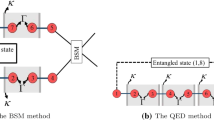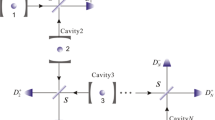Abstract
We consider entangled state production utilizing a full optomechanical arrangement, based on which we create entanglement between two far three-level V-type atoms using a quantum repeater protocol. At first, we consider eight identical atoms (1,2,⋯ ,8), while adjacent pairs (i,i + 1) with i = 1,3,5,7 have been prepared in entangled states and the atoms 1, 8 are the two target atoms. The three-level atoms (1,2,3,4) and (5,6,7,8) distinctly become entangled with the system including optical and mechanical modes by performing the interaction in optomechanical cavities between atoms (2,3) and (6,7), respectively. Then, by operating appropriate measurements, instead of Bell state measurement which is a hard task in practical works, the entangled states of atoms (1,4) and (5,8) are achieved. Next, via interacting atoms (4,5) of the pairs (1,4) and (5,8) and operating proper measurement, the entangled state of target atoms (1,8) is obtained. In the continuation, entropy and success probability of the produced entangled state are then evaluated. It is observed that the time period of entropy is increased by increasing the mechanical frequency (ωM) and by decreasing optomechanical coupling strength to the field modes (G). Also, in most cases, the maximum of success probability is increased by decreasing G and via decreasing ωM.





Similar content being viewed by others
Notes
Each ket of (5) is related to \(|{(a_{1}, a^{\dagger }_{1}),(a_{2}, a^{\dagger }_{2});(b_{1}, b^{\dagger }_{1}),(b_{2}, b^{\dagger }_{2});\text {atom}1(5),\text {atom} 2(6);\text {atom} 3(7),\text {atom} 4(8)}\rangle \). For instance, the first term in state (5), i.e., \(|0, 0; 0, 0;\widetilde {1},\widetilde {3};\widetilde {3},\widetilde {1} \rangle \), means that the optical and the mechanical modes are in the vacuum state |0, 0〉⊗|0, 0〉 and the atoms 1, 2 (as well as 5, 6) are in the state \(|\widetilde {1},\widetilde {3}\rangle \) and the atoms 3, 4 (as well as 7, 8) are in the state \(|\widetilde {3},\widetilde {1}\rangle \).
The ket |0, 0〉 (in the projection operator with the state \(|0, 0 \rangle \otimes |\widetilde {3},\widetilde {1}\rangle \)) is related to optical and mechanical mode denoted by \((a_{1}, a^{\dagger }_{1})\) and \((b_{1}, b^{\dagger }_{1})\), respectively. Also, the state \(|\widetilde {3},\widetilde {1}\rangle \) is related to atoms 2, 3 (and 6, 7). These explanations can be easily repeated for state \(|0, 0 \rangle \otimes |\widetilde {1},\widetilde {3}\rangle \).
Each ket of (11) is related to \(|{(a_{1}, a^{\dagger }_{1}),(a_{2}, a^{\dagger }_{2});(b_{1}, b^{\dagger }_{1}),(b_{2}, b^{\dagger }_{2});\text {atom}1,\text {atom}4;\text {atom}5,\text {atom}8}\rangle \). The used method to calculate the coefficients of state (11) has been explained in Appendix C.
Note that the ket |0, 0〉 is related to optical and mechanical mode denoted by \((a_{1}, a^{\dagger }_{1})\) and \((b_{1}, b^{\dagger }_{1})\), respectively, also, the state \(|\widetilde {3},\widetilde {1}\rangle \) is related to atoms 4, 5.
Note that the ket |0, 0〉 is related to optical and mechanical mode denoted by \((a_{1}, a^{\dagger }_{1})\) and \((b_{1}, b^{\dagger }_{1})\), respectively, also, the state \(|\widetilde {1},\widetilde {3}\rangle \) is related to atoms 4, 5.
References
Briegel, H.-J., Dür, W., Cirac, J.I., Zoller, P.: . Phys. Rev. Lett. 81, 5932 (1998)
Bernad, J.Z.: . Phys. Rev. A 96, 052329 (2017)
Ghasemi, M., Tavassoly, M.K.: . Quantum Inf. Process. 18, 113 (2019)
Ghasemi, M., Tavassoly, M.K.: . J. Phys. B: At. Mol. Opt. Phys. 52, 085502 (2019)
Agarwal, G.S.: Quantum Optics. Cambridge University Press, Cambridge (2012)
Pakniat, R., Zandi, M.H., Tavassoly, M.K.: . Eur. Phys. J. Plus 132, 3 (2017)
Ghasemi, M., Tavassoly, M.K.: . Eur. Phys. J. Plus 131, 297 (2016)
Ghasemi, M., Tavassoly, M.K., Nourmandipour, A.: . Eur. Phys. J. Plus 132, 531 (2017)
Nourmandipour, A., Tavassoly, M.K., Mancini, S.: . Quantum Inf. Comput. 16, 11 (2016)
Pakniat, R., Tavassoly, M.K., Zandi, M.H.: . Chin. Phys. B 25, 100303 (2016)
Yang, M., Song, W., Cao, Z.-L.: . Phys. Rev. A 71, 034312 (2005)
Pakniat, R., Tavassoly, M.K., Zandi, M.H.: . Opt. Commun. 382, 381 (2017)
Pakniat, R., Soltani, M., Tavassoly, M.K.: . J. Int. Mod. Phys. B 32, 1850093 (2018)
Jaynes, E.T., Cummings, F.W.: . Proc. IEEE 51, 89 (1963)
Shen, L.-T., Shi, Z.-C., Wu, H.-Z., Yang, Z.-B.: . Entropy 19, 331 (2017)
Tavis, M., Cummings, F.W.: . Phys. Rev. 170, 379 (1968)
Wang, X.-C., Yang, M.: . Int. J. Theor. Phys. 50, 1479 (2011)
Wang, W., Cao, H.: . Int. J. Theor. Phys. 52, 2099 (2013)
Song, Y., Li, Y., Wang, W.: . Int. J. Theor. Phys. 57, 1559 (2018)
Tittel, W., Afzelius, M., Chaneliere, T., Cone, R.L., Kröll, S., Moiseev, S.A., Sellars, M.: . Laser Photonics Rev. 4, 244 (2010)
Li, T., Yang, G.-J., Deng, F.-G.: . Phys. Rev. A 93, 012302 (2016)
Wang, T.-J., Song, S.-Y., Long, G.L.: . Phys. Rev. A 85, 062311 (2012)
Zhao, B., Müller, M., Hammerer, K., Zoller, P.: . Phys. Rev. A 81, 052329 (2010)
Ladd, T.D., van Loock, P., Nemoto, K., Munro, W.J., Yamamoto, Y.: . New J. Phys. 8, 184 (2006)
Yi, X.-F., Xu, P., Yao, Q., Quan, X.: . Quantum Inf. Process. 18, 82 (2019)
Ghasemi, M., Tavassoly, M.K.: . EPL (Europhysics Letters) 123, 24002 (2018)
Ghasemi, M., Tavassoly, M.K.: . Laser Phys. 29, 085202 (2019)
Ghasemi, M., Tavassoly, M.K.: . J. Opt. Soc. Am. B 36, 10 (2019)
Ghasemi, M., Tavassoly, M.K.: . Phys. Lett. A 384, 28 (2020)
Bougouffa, S., Al-Hmoud, M.: . Int. J. Theor. Phys. 59, 6 (2020)
Rehaily, A.A., Bougouffa, S.: . Int. J. Theor. Phys. 56, 5 (2017)
Bougouffa, S., Ficek, Z.: . Phys. Rev. A 102, 4 (2020)
Al-Awfi, S., Al-Hmoud, M., Bougouffa, S.: . EPL (Europhysics Letters) 123, 1 (2018)
Joshi, A., Xiao, M.: . Opt. Commun. 232, 1–6 (2004)
Weidinger, M., Varcoe, B.T.H., Heerlein, R., Walther, H.: . Phys. Rev. Lett. 82, 19 (1999)
Vanner, M.R., Aspelmeyer, M., Kim, M.S.: . Phys. Rev. Lett. 110, 1 (2013)
Li, J., Groblacher, S., Zhu, S.Y., Agarwal, G.S.: . Phys. Rev. A 98, 1 (2018)
Ho, M., Oudot, E., Bancal, J.D., Sangouard, N.: . Phys. Rev. Lett. 121, 2 (2018)
Schwab, K.C., Roukes, M.L.: . Phys. Today 58, 36 (2005)
Liu, N., Li, J., Liang, J.-Q.: . Int. J. Theor. Phys. 52, 706 (2013)
Nadiki, M.H., Tavassoly, M.K.: . Laser Phys. 26, 125204 (2016)
Nadiki, M.H., Tavassoly, M.K.: . Ann. Phys. 386, 275 (2017)
Nadiki, M.H., Tavassoly, M.K., Yazdanpanah, N.: . Eur. Phys. J. D 72, 110 (2018)
Aspelmeyer, M., Kippenberg, T.J., Marquardt, F.: . Rev. Mod. Phys. 86, 1391 (2014)
Camerer, S., Korppi, M., Jockel, A., Hunger, D., Hansch, T.W., Treutlein, P.: . Phys. Rev. Lett. 107, 22 (2011)
Ian, H., Gong, Z.R., Liu, Y.-X., Sun, C.P., Nori, F.: . Phys. Rev. A 78, 1 (2008)
Wang, J., Tian, X.-D., Liu, Y.-M., Cui, C.-L., Wu, J.-H.: . Laser Phys. 28, 6 (2018)
Bai, C.-H., Wang, D.-Y., Wang, H.-F., Zhu, A.-D., Zhang, S.: Sci. Rep 6 (2016)
Liao, Q.-H., Zhang, Q., Zhou, N.-R.: . J. Korean Phys. Soc. 69, 4 (2016)
Liao, Q.H., Nie, W.J., Xu, J., Liu, Y., Zhou, N.R., Yan, Q.R., Chen, A., Liu, N.H., Ahmad, M.A.: . Laser Phys. 26, 5 (2016)
Barzanjeh, S. h., Naderi, M.H., Soltanolkotabi, M.: . Phys. Rev. A 84, 6 (2011)
Zhou, L., Han, Y., Jing, J., Zhang, W.: . Phys. Rev. A 83, 052117 (2011)
Bagheri, M., Poot, M., Li, M., Pernice, W.P.H., Tang, H.X.: . Nat. Nanotechnol. 6, 726 (2011)
Ludwig, M., Safavi-Naeini, A.H., Painter, O., Marquardt, F.: . Phys. Rev. Lett. 109, 063601 (2012)
Vitali, D., Gigan, S., Ferreira, A., Bohm, H.R., Tombesi, P., Guerreiro, A., Vedral, V.: . Phys. Rev. Lett. 98, 3 (2007)
Wang, Y.-D., Clerk, A.A.: . Phys. Rev. Lett. 110, 25 (2013)
Hofer, S.G., Wieczorek, W., Aspelmeyer, M., Hammerer, K.: . Phys. Rev. A 84, 5 (2011)
Liao, J.-Q., Wu, Q.-Q., Nori, F.: . Phys. Rev. A 89, 1 (2014)
Aloufi, K. h., Bougouffa, S., Ficek, Z.: . Phys. Scr. 90, 074020 (2015)
Courty, J.-M., Heidmann, A., Pinard, M.: . Eur. Phys. J. D: At. Mol. Opt. Plasma Phys. 17, 3 (2001)
Page, M.A., Zhao, C., Blair, D.G., Ju, L., Ma, Y., Pan, H.-W., Chao, S., Mitrofanov, V.P., Sadeghian, H.: . J. Phys. D: Appl. Phys. 49, 45 (2016)
Rosenfeld, W., Weber, M., Volz, J., Henkel, F., Krug, M., Cabello, A., Zukowski, M., Weinfurter, H.: . Adv. Sci. Lett. 2, 4 (2009)
Feng, X.-L., Zhang, Z.M., Li, X.D., Gong, S.Q., Xu, Z.Z.: . Phys. Rev. Lett. 90, 21 (2003)
Hofmann, J., Krug, M., Ortegel, N., Gerard, L., Weber, M., Rosenfeld, W., Weinfurter, H.: . Science 337, 6090 (2012)
James, D.F.V., Jerke, J.: . Can. J. Phys. 85, 625 (2007)
Gamel, O., James, D.F.V.: . Phys. Rev. A 82, 052106 (2010)
Author information
Authors and Affiliations
Corresponding author
Additional information
Publisher’s Note
Springer Nature remains neutral with regard to jurisdictional claims in published maps and institutional affiliations.
Appendices
Appendix A: The used approach to obtain the effective Hamiltonian (4)
As mentioned prior to (4), following the approach explained in Refs. [65, 66], the effective Hamiltonian (4) can be obtained. In this approach, at first using the Hamiltonian (2) and the following Baker-Hausdorff lemma:
the Hamiltonian in the interaction picture is obtained. As stated in Refs. [65, 66], after calculating the Hamiltonian in the interaction picture with the following form:
the effective Hamiltonian can be obtained as below:
In (24), (25), ωn(m) > 0 is frequency and N is the total number of different harmonic terms making up the interaction Hamiltonian. Also, ωmn is defined by the following equation:
which may be considered as the harmonic average of ωm and ωn. In our case, the effective Hamiltonian (4) has been obtained using (3), (24), (25) and (26).
Appendix B: Calculating the coefficients of entangled state (5)
In this section, the differential equations related to the state (5) with the help of effective Hamiltonian (4) and the time-dependent Schrödinger equation are obtained as \(\dot {X}=SX\), where \(\dot {X}\) and S are respectively defined as follow,
The equation \(\dot {A}_{1}(t)=0\) easily results in \(A_{1}(t)=\frac {1}{2}\). Also, paying attention to the considered initial conditions, we find that A2(t) = A9(t), A3(t) = A10(t), A4(t) = A11(t) and A6(t) = A7(t). Now, using Laplace transform and with the help of Mathematica software, the coefficients A4(t), A5(t), A8(t) and then the coefficients A2(t), A3(t) and A6(t) can be calculated, however, due to their complex and lengthy forms we ignore presenting their explicit forms.
Appendix C: Calculating the coefficients of entangled state (11)
The differential equations related to state (11) using the effective Hamiltonian (10) and the time-dependent Schrödinger equation are obtained as \(\dot {Y}=SY\), where S has been defined in (28) and \(\dot {Y}\) is defined as follows,
Paying attention to (17), (20), it may be seen that, knowing the coefficients \({B^{i}_{2}}(\tau )\), \({B^{i}_{3}}(\tau )\), \({B^{i}_{9}}(\tau )\) and \(B^{i}_{10}(\tau )\) is enough for our purpose, and these coefficients can be obtained after calculating \({B^{i}_{4}}(\tau )\) and \(B^{i}_{11}(\tau )\) using Laplace transform and with the help of Mathematica software.
Rights and permissions
About this article
Cite this article
Ghasemi, M., Tavassoly, M.K. Distributed Entangled State Production by Using Quantum Repeater Protocol. Int J Theor Phys 60, 1870–1882 (2021). https://doi.org/10.1007/s10773-021-04806-z
Received:
Accepted:
Published:
Issue Date:
DOI: https://doi.org/10.1007/s10773-021-04806-z




